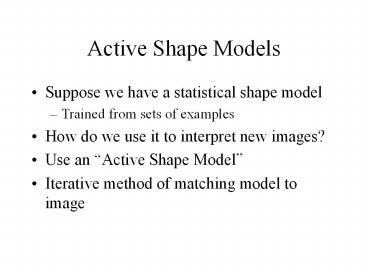Active Shape Models - PowerPoint PPT Presentation
Title:
Active Shape Models
Description:
How do we use it to interpret new images? Use an 'Active Shape Model' ... ASM Example : Hip Radiograph. ASM Example: Spine. Active Shape Models. Advantages ... – PowerPoint PPT presentation
Number of Views:57
Avg rating:3.0/5.0
Title: Active Shape Models
1
Active Shape Models
- Suppose we have a statistical shape model
- Trained from sets of examples
- How do we use it to interpret new images?
- Use an Active Shape Model
- Iterative method of matching model to image
2
Building Models
- Require labelled training images
- landmarks represent correspondences
3
Building Shape Models
- Given aligned shapes,
- Apply PCA
- P First t eigenvectors of covar. matrix
- b Shape model parameters
4
Hand Shape Model
5
Active Shape Models
- Match shape model to new image
- Require
- Statistical shape model
- Model of image structure at each point
Model Point
Model of Profile
6
Placing model in image
- The model points are defined in a model
co-ordinate frame - Must apply global transformation,T, to place in
image
Model Frame
Image
7
ASM Search Overview
- Local optimisation
- Initialise near target
- Search along profiles for best match,X
- Update parameters to match to X.
8
Local Structure Models
- Need to search for local match for each point
- Model
- Strongest edge
- Correlation
- Statistical model of profile
9
Computing Normal to Boundary
Tangent
Normal
(Unit vector)
10
Sampling along profiles
Profile normal to boundary
Model boundary
Interpolate at these points
Model point
11
Noise reduction
- In noisy images, average orthogonal to profile
- Improves signal-to-noise along profile
12
Searching for strong edges
Select point along profile at strongest edge
13
Profile Models
- Sometimes true point not on strongest edge
- Model local structure to help locate the point
True position
Strongest edge
14
Statistical Profile Models
- Estimate p.d.f. for sample on profile
- Normalise to allow for global lighting variations
- From training set learn
15
Profile Models
- For each point in model
- For each training image
- Sample values along profile
- Normalise
- Build statistical model
- eg Gaussian PDF using eigen-model approach
16
Searching Along Profiles
- During search we look along a normal for the best
match for each profile
Form vector from samples about x
17
Search algorithm
- Search along profile
- Update global transformation, T, and parameters,
b, to minimise
18
Updating parameters
- Find pose and model parameters to minimise
- Either
- Put into general optimiser
- Use two stage iterative approach
19
Updating Parameters
Repeat until convergence
Analytic solution exists (see notes)
20
Update step
- Hard constraints
- Soft constraints
- Can also weight by quality of local match
21
Multi-Resolution Search
- Train models at each level of pyramid
- Gaussian pyramid with step size 2
- Use same points but different local models
- Start search at coarse resolution
- Refine at finer resolution
22
Gaussian Pyramids
- To generate image at level L
- Smooth image at level L-1 with gaussian filter
(eg (1 5 8 5 1)/20) - Sub-sample every other pixel
Each level half the size of the one below
23
Multi-Resolution Search
- Start at coarse resolution
- For each resolution
- Search along profiles for best matches
- Update parameters to fit matches
- (Apply constraints to parameters)
- Until converge at this resolution
24
ASM Example Hip Radiograph
25
ASM Example Spine
26
Active Shape Models
- Advantages
- Fast, simple, accurate
- Efficient to extend to 3D
- Disadvantages
- Only sparse use of image information
- Treat local models as independent































